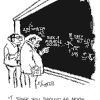29.4.2008 | 08:34
Ýmislegt vinnur gegn verđbólgunni, td. er menntun í raun fyrir löngu orđin ókeypis á netinu og amk. áratugur síđan almennir skólar urđu úreltir
- Physics I
- Physics II
- Physics III
- Physics IV
- Nanotechnology
- Mathematics I
- Advanced Mathematics
- Computer Science (CS)
- More Computer Science
- Computer Science & Programming
- Machine Learning & Artificial Intelligence
- Scalability & Scalable Architectures
- Theoretical CS & Maths
- Web and Functional Programming
- Programming, Networking & Others
- Programming Lectures and Tutorials
- Programming Language Video Lectures
- Google TechTalk CS
- Electrical Engineering
- EE & Mechanical Engineering
- Chemistry and Biology
- Cognitive Sciences
- Economics and Economy
- Business and Management
- History
- Psychology
- Medicine
Og margt fleira.
Um bloggiđ
Baldur Fjölnisson
Nýjustu fćrslur
- Torfi Stefáns bannađur ćvilangt
- OL í skák. Landinn malađi Keníu í 9. umferđ
- OL í skák: Landinn í 88. sćti eftir 8 umferđir
- Međaljónar í skákinni
- Baggalútur - Sagan af Jesúsi
- Eitrađ fyrir lýđnum?
- Óvenjulega döpur taflmennska innfćddra einkennir Reyjavíkursk...
- U.S. Rushes Coolant to Japanese Nuke Plant After Earthquake
Heimsóknir
Flettingar
- Í dag (18.5.): 1
- Sl. sólarhring: 2
- Sl. viku: 23
- Frá upphafi: 116011
Annađ
- Innlit í dag: 1
- Innlit sl. viku: 23
- Gestir í dag: 1
- IP-tölur í dag: 1
Uppfćrt á 3 mín. fresti.
Skýringar
Bloggvinir
-
 Agný
Agný
-
 Alfreð Símonarson
Alfreð Símonarson
-
 Andrea J. Ólafsdóttir
Andrea J. Ólafsdóttir
-
 Bjarni Harðarson
Bjarni Harðarson
-
 Bjarni Kjartansson
Bjarni Kjartansson
-
 Björgvin Gunnarsson
Björgvin Gunnarsson
-
 Brynjar Jóhannsson
Brynjar Jóhannsson
-
 FLÓTTAMAÐURINN
FLÓTTAMAÐURINN
-
 Eygló Þóra Harðardóttir
Eygló Þóra Harðardóttir
-
 FreedomFries
FreedomFries
-
 Fríða Eyland
Fríða Eyland
-
 Félag um stafrænt frelsi á Íslandi
Félag um stafrænt frelsi á Íslandi
-
 Georg P Sveinbjörnsson
Georg P Sveinbjörnsson
-
 Gestur Guðjónsson
Gestur Guðjónsson
-
 Gils N. Eggerz
Gils N. Eggerz
-
 Gullvagninn
Gullvagninn
-
 Gunnar Skúli Ármannsson
Gunnar Skúli Ármannsson
-
 Guðrún María Óskarsdóttir.
Guðrún María Óskarsdóttir.
-
 Gísli Hjálmar
Gísli Hjálmar
-
 Hagbarður
Hagbarður
-
 Halla Rut
Halla Rut
-
 Haraldur Haraldsson
Haraldur Haraldsson
-
 Hilmar Kári Hallbjörnsson
Hilmar Kári Hallbjörnsson
-
 Hlekkur
Hlekkur
-
 Ingibjörg Álfrós Björnsdóttir
Ingibjörg Álfrós Björnsdóttir
-
 Jens Guð
Jens Guð
-
 Jóhannes Ragnarsson
Jóhannes Ragnarsson
-
 Jón Aðalsteinn Jónsson
Jón Aðalsteinn Jónsson
-
 Jón Ragnarsson
Jón Ragnarsson
-
 Jón Steinar Ragnarsson
Jón Steinar Ragnarsson
-
 Jónína Benediktsdóttir
Jónína Benediktsdóttir
-
 Karl Tómasson
Karl Tómasson
-
 Kári Magnússon
Kári Magnússon
-
 Loopman
Loopman
-
 Magnús Þór Hafsteinsson
Magnús Þór Hafsteinsson
-
 Promotor Fidei
Promotor Fidei
-
 Rúnar Sveinbjörnsson
Rúnar Sveinbjörnsson
-
 Salvör Kristjana Gissurardóttir
Salvör Kristjana Gissurardóttir
-
 Sandra María Sigurðardóttir
Sandra María Sigurðardóttir
-
 SeeingRed
SeeingRed
-
 Sigurbjörn Friðriksson
Sigurbjörn Friðriksson
-
 Sigurjón Þórðarson
Sigurjón Þórðarson
-
 Sigurður Þórðarson
Sigurður Þórðarson
-
 Snorri Hrafn Guðmundsson
Snorri Hrafn Guðmundsson
-
 el-Toro
el-Toro
-
 Sveinn Ingi Lýðsson
Sveinn Ingi Lýðsson
-
 Tryggvi Hjaltason
Tryggvi Hjaltason
-
 TómasHa
TómasHa
-
 Túrilla
Túrilla
-
 Upprétti Apinn
Upprétti Apinn
-
 gudni.is
gudni.is
-
 haraldurhar
haraldurhar
-
 proletariat
proletariat
-
 Ívar Pálsson
Ívar Pálsson
-
 Ómar Ragnarsson
Ómar Ragnarsson
-
 Ónefnd
Ónefnd
-
 Óskar
Óskar
-
 Óskar Helgi Helgason
Óskar Helgi Helgason
-
 Óskar Þ. G. Eiríksson
Óskar Þ. G. Eiríksson
-
 Þórir Kjartansson
Þórir Kjartansson
-
 Arnar Guðmundsson
Arnar Guðmundsson
-
 Bara Steini
Bara Steini
-
 Birgir R.
Birgir R.
-
 Birgir Rúnar Sæmundsson
Birgir Rúnar Sæmundsson
-
 brahim
brahim
-
 Brosveitan - Pétur Reynisson
Brosveitan - Pétur Reynisson
-
 Bwahahaha...
Bwahahaha...
-
 Dingli
Dingli
-
 eysi
eysi
-
 Gestur Kristmundsson
Gestur Kristmundsson
-
 Guðbjörg Elín Heiðarsdóttir
Guðbjörg Elín Heiðarsdóttir
-
 Gunnar Helgi Eysteinsson
Gunnar Helgi Eysteinsson
-
 Gunnar Rögnvaldsson
Gunnar Rögnvaldsson
-
 Helgi Jóhann Hauksson
Helgi Jóhann Hauksson
-
 Hlini Melsteð Jóngeirsson
Hlini Melsteð Jóngeirsson
-
 Jakobína Ingunn Ólafsdóttir
Jakobína Ingunn Ólafsdóttir
-
 Katrín Snæhólm Baldursdóttir
Katrín Snæhólm Baldursdóttir
-
 kreppukallinn
kreppukallinn
-
 Kristín Magdalena Ágústsdóttir
Kristín Magdalena Ágústsdóttir
-
 Máni Ragnar Svansson
Máni Ragnar Svansson
-
 Morgunblaðið
Morgunblaðið
-
 Neo
Neo
-
 Orgar
Orgar
-
 Ragnar L Benediktsson
Ragnar L Benediktsson
-
 Rauði Oktober
Rauði Oktober
-
 Skákfélagið Goðinn
Skákfélagið Goðinn
-
 Sveinn Þór Hrafnsson
Sveinn Þór Hrafnsson
-
 Vilhjálmur Árnason
Vilhjálmur Árnason
-
 Þór Ludwig Stiefel TORA
Þór Ludwig Stiefel TORA




Athugasemdir
http://freescienceonline.blogspot.com/
C Programming (N305, Indiana and Purdue Universities)
Course topics:
Introduction to Computers: Hardware and Languages. Programming: First C Program. Mixing Data Types. Basic IO: printf() and scanf(). Variable Declarations, Data Types, Expressions: Variables and Operators. Assignments. Algorithms. Standard C Statements. Functions: Declarations. Information Representation: Positive Integers, Negative Integer Representation, Floating Point Representation, Characters and Images, Machine Instructions. Arrays: Strings and Multidimensional Arrays. Literals and Variables.
Essential Concepts of Computer Science (N301, Indiana and Purdue Universities)
Course topics:
History of Computing. Analog and Digital Representation. Binary Notation. Extending Binary. Two's Complement Notation. Floating Point Notation. Basic Logic Gates. Building a Half Adder. Building a Full Adder. Building a Subtracter. Building an ALU. Von Neumann Architectue. The Fetch-Execute Cycle. Basic Machine Language. Repetition in Machine Language. Beginning Algorithms. Branching Mechanisms. Looping. Complexity in Algorithms. Measuring Complexity. Encapsulation. Software Engineering. Software Engineering Models.
Principles of Computing (N100, Indiana and Purdue Universities)
Course topics:
Basic problem-solving with STAIR (Stating the problem, Tools, Algorithms, Implementation, Refinement). The universal information manipulator. Lights, Legos, and Numbers. Converting from binary to and from base 10. Basic logic gates. Storing data in ABNIAC. ASCII representation in ABNIAC. Addition and looping in ABNIAC.
Introduction to Web Design (N241, Indiana and Purdue Universities)
Course topics:
Basic HTML. Validation. CSS. Fonts and Colors in CSS. Binary, Decimal, Octal, Hex. Internet Addressing. Linux. Overview of Unix. Basic Unix Commands. Permissions. Colors and Images. Science of Colors. GIF. Learning Emacs. XHTML Images, Links, and Lists. Layout with CSS. Buttons in CSS. CSS Layout with Float. Tables. Cross-Browser CSS. Adding Audio. Multimedia With Flash. Multimedia with Wax. Basic Image Swapping. Rollover Buttons. Extending HTML.
Client Side Web Programming (N341, Indiana and Purdue Universities)
Course topics:
Program Development. Documenting Your Code. Introducing Programming. Object Oriented Concepts. Working with Variables. Dialogue Windows. String Objects. Number and Math Objects. If-Then-Else Structures. Switch Statements. Complex Conditions. Conditional Loops. Introducing Arrays. Multidimensional Arrays. JavaScript Modularity. Browser Objects. Introducing DOM. Regular Expressions. JavaScript and Forms. Form Validation. Window Object. Document Object. Cascading Style Sheets. Styles with JavaScript. Cookies.
Server-Side Web Development (N342, Indiana and Purdue Universities)
Course topics:
Intro to Server-Side Programming. Programming on the Web Server. Installing Apache on Windows. Installing PHP in Windows. Configuring PHP. Installing an IDE. Creating your 1st PHP Program. Preparing your Code. Using Variables. Complex String Variables. Responding to HTML Forms. Responding to Complex Forms. Creating Random Numbers. If Statement. Functions. Function Parameters. Variable Scope. Persistence. For and While Loops. Basic Arrays. Responding to Checkboxes. Associative Arrays. Multidimensional Arrays. Multi-Array. String Manipulation. Saving and Loading Files. Files. Directories. Mail. Using Regular Expressions. Introducing MySQL. Tables. Queries. Connecting to a Database within PHP. Examining Entities and Relationships. Joins. Innerjoins. Many to Many Joins.
Visual Basic .NET (N331, Indiana and Purdue Universities)
Course topics:
Inside Visual Studio. Buttons. Labels. Text Boxes. Check Boxes. List Boxes. Combo Boxes. Five Programming Steps. Variables. Branching. If. Then. Else. Looping. Do. While. For. Next. Arrays. Menus.
ASP.NET (N431, Indiana and Purdue Universities)
Course topics:
.NET Intro. Web Controls. Form Validation. Required Field Validator. Specialized Validators. Text Files vs Databases. Database Introduction. SQL Introduction. Insert. Update. Data Binding. Data List. Data Grid. Data Set Sorting. Tracking User Sessions. Session States. Caching. Error Handling. Forms-Based Authentication. Security. Local Encryption. Sending Mail.
Advanced Programming (N335, Indiana and Purdue Universities)
Course topics:
What is .NET. Programming Intro. Object Orientation. .Net Namespaces. Data Type. Strings. Dates. Creating a Class. Polymorphism. Inheritance. Creating Folders. Multithreading. SQL Overview. Data Wizards. Data Sets.
Programming Concepts and Data (N201, Indiana and Purdue Universities)
Course topics:
Problem Solving. Background, History, and Fundamentals of Computing. Working With HTML. History of Programming Languages. Machine Language. Miracle. Conditions. Using Loops. Javascript. Functions. Working with Arrays. Introduction to Databases.
Data Analysis Using Spread Sheets (N207, Indiana and Purdue Universities)
Course topics:
Introduction to STAIR. Computer Hardware. Binary, Hexidecimal, and ASCII. Computer Software. Computer Security. Webpages, Websites, and E-Commerce. Databases. Introduction to Spreadsheets. Charts. Univariate Data Analysis. Multivariate Data Analysis. Regression.
XML with Java (E-259, Harvard University)
Course description:
This course introduces XML as a key enabling technology in Java-based applications. Students learn the fundamentals of XML and its derivatives, including DTD, SVG, XML Schema, XPath, XQuery, XSL-FO, and XSLT. Students also gain experience with programmatic interfaces to XML like SAX and DOM, standard APIs like JAXP and TrAX, and industry-standard software like Ant, Tomcat, Xerces, and Xalan. The course acquaints students with J2EE, including JavaServer Pages (JSP) and Java Servlet, and also explores HTTP, SOAP, web services, and WSDL. The course's projects focus on the implementation and deployment of these technologies.
Course topics:
XML 1.1 and SAX 2.0.2. DOM Level 3, XPath 1.0 (and 2.0) and XSLT 1.0 (and 2.0). Namespaces in XML 1.1 (Second Edition), SVG 1.1, and XSL (XSL-FO) 1.1. HTTP 1.1, JavaServer Pages 2.1, and Java Servlet 2.5. XQuery 1.0 and DTD. XML Schema (Second Edition). Web Services, SOAP 1.2, and WSDL 1.1. Ajax.
Algorithms for Nearest Neighbor Search (by Yury Lifshits)
Video | Slides | Download Video
Video | Slides | Download Video
Video | Slides | Download Video
Video | Slides | Download Video
Similarity Search: A Web Perspective (by Yuri Lifshits)
Lecture description:
Similarity search is the problem of preprocessing a database of N objects in such a way that given a query object, one can effectively determine its nearest neighbors in database. "Geometric near-neighbor access tree" data structure, an early work (1995) by Sergey Brin, is one of the most known solutions to this problem.
Similarity search is closely connected to many algorithmic problems in the web. Similarity search is an abstraction of many algorithmic problems we face in data management. In this talk we will focus on:
- Personalized news aggregation: Searching for news articles that are most similar to the user's profile of interests.
- Behavioral targeting: Searching for the most relevant advertisement for displaying to a given user.
- Social network analysis: Suggesting new friends.
- Computing co-occurrence similarities.
- "Best match search": Searching resumes, jobs, boyfriends, girlfriends, cars, apartments.
The lecture describes features that make web applications somewhat different from previously studied models. Thus the lecturer re-examine the formalization and the classical algorithms for similarity search. This leads us to new algorithms (Yuri present two of them) and numerous open problems in the field.
Functional Programming Seminar
Simon Peyton-Jones: "Taming Effects - The Next Big Challenge"
Satnam Singh: "Declarative Programming Techniques for Many-Core Architectures"
John Hughes: "Testing with QuickCheck"
Simon Peyton-Jones: "Composing Contracts - An Adventure in Financial Engineering"
John Launchbury: "High-Assurance Software"
Nested Data Parallelism in Haskell (by Simon Peyton-Jones)
Design Patterns as Higher-Order Datatype Generic Programs
Lecture by Dr Jeremy Gibbons of Oxford Computing Lab.
Games in Haskell (by Matthew Sackman)
XMonad - A Haskell Success Story
After all these mind boggling functional programming video lectures, here is a video for relaxation about Claude Shannon, founder of the field of information theory.
Claude Shannon - Father of the Information Age
Video contents:
Considered the founding father of the electronic communication age, Claude Shannon's work ushered in the Digital Revolution. This fascinating program explores his life and the major influence his work had on today's digital world through interviews with his friends and colleagues.
Have fun with these lectures! Until next time! :)
Baldur Fjölnisson, 29.4.2008 kl. 08:38
Ég tek vel undir ţađ ađ fólk nýti ţađ sem er hćgt ađ finna á netinu. Framhalds skóla vil ég ađ fólk borgi fyrir og ađ ţeir gangi ekki nema ţeir geti lađađ fólk til sín vegna vinsćlda. Međ öđrum orđum enga ríkisstyrki fyrir farmhalds menntun.
Valdimar Samúelsson, 29.4.2008 kl. 08:50
Ţetta er flott, bendi líka á ókeypis fyrirlestra og hugvekjur um heimspeki, dulda sögu (baktjaldasagan) og skýringar á atburđum nútímans hjá Alan Watt - ţađ er ókeypis podcast áskrift ađ finna á síđunni.
Gullvagninn (IP-tala skráđ) 29.4.2008 kl. 08:58
Sammála.
Ţetta var algjörlega orđiđ augljóst fyrir áratug en ţví miđur stjórnar fólk međ alvarlegan athyglisbrest og takmarkađa vitsmuni ţessum málum og hefur augljóslega veriđ sérvaliđ í ţau.
Baldur Fjölnisson, 29.4.2008 kl. 09:01
Ég vil skera niđur löngu úrelt ríkisapparat sem hér hefur veriđ hróflađ upp - og lćkka skatta. Fólk ţarf auknar ráđstöfunartekjur til ađ standa undir sínu skuldafargani og almennri okurhefđ sem hér ríkir.
Í heiminum hafa sl. 1-2 áratugi vegist á verđbólga og verđhjöđnun. Gífurleg verđhjöđnun og framleiđniaukning hefur komiđ frá tćkniframförum og ekki síst internetinu og hún hefur unniđ á móti óđaverđbólgu sem ótćpileg skuldapappíraframleiđsla hefur valdiđ. Hin raunverulega verđbólga hefur sem sagt veriđ í pappírum og húseignum eins og svo oft hefur komiđ fram hérna á blogginu. Á síđustu misserum hefur hún síđan veriđ ađ hlaupa yfir í hráefni og matvćli, möo markađurinn er ađ flýja ónýta og ofútgefna pappírsgjaldmiđla og sápukúlur sem ţeim fylgja.
Baldur Fjölnisson, 29.4.2008 kl. 09:21
Previous
http://freescienceonline.blogspot.com/
Baldur Fjölnisson, 29.4.2008 kl. 09:33
Instructor: Philip Greenspun submitted on 18 April, 2008
Teaches basics of designing a dynamic web site with a database back end, including scripting languages, cookies, SQL, and HTML with the goal of building such a site as the main (group) project Emphasizes computer-human interface and the graphical display of information.
Southwest Wisconsin Technical College submitted on 17 April, 2008
Microbiology, Micro Immunology, Micro-Genetics, Micro-Nutrition, Procar cell Nutrition, cells etc...
Southwest Wisconsin Technical College spring 2008 submitted on 17 April, 2008
Infertility, Endometriosis, Assessment of Reproductive System, Critical-Life Threatening Situations, Alterations GI, Inflammatory Intestinal, Gastrointestinal Alterations etc...
New Jersey Institute of Technology submitted on 17 April, 2008
New Jersey Institute of Technology submitted on 17 April, 2008
by Neil Daswani at google.com Summer 2007 submitted on 16 April, 2008
Topics: How to Break Web Software, What Every Engineer Needs to Know About Security and Where to Learn It.
killerajax.com submitted on 16 April, 2008
Introduction to Ajax and Overview of the Ajax Shopping Cart Ajax Tools,Overview of the Source Files etc...
submitted on 16 April, 2008
How to download video lectures available here, MIT OCW, UC Berkeley, and on any other website
http://www.freevideolectures.com/
Baldur Fjölnisson, 29.4.2008 kl. 09:34
Ţrátt fyrir örvćntingarfulla grćđgisvćđingu og grćđgisinnrćtingu ríkisapparats sem augljóslega er alfariđ í eigu fyrirtćkja og fjármagnsafla innlendra og erlendra - er samt meira en nóg til af hugsjónamönnum sem gefa vinnu sína og framleiđslu og hugverk og ţá ber ađ nýta fjöldanum til sparnađar og hagsmuna og framdráttar.
Hér er td. rafmagnsfrćđi frá a til ö og ýmislegt ţví tengt - allt gefins:
Access individual volumes, I through VI:
Checkout the Socratic Electronics Project.
We are sometimes asked for homework questions. While the Socratic Electronics Project does not provide questions keyed to specific chapters, it does provide questions related to various electrical/electronic topics in the form of "work sheets". The basic concept is to encourage active as opposed to passive learning.
Checkout allaboutcircuits.
Have questions about electronics, math, physics, embedded systems, programming? Need help with homework? Checkout these and other forums at allaboutcircuits. Ask your question at one of the forums. Curious about questions your peers ask? Want to report errors you find in our text? Report errors at feedback and suggestions forum. See example of an error submission to allaboutcircuits.
http://www.ibiblio.org/kuphaldt/electricCircuits/
Baldur Fjölnisson, 29.4.2008 kl. 09:59
Ţannig leitarđu td. ađ ţessum hlutum á google
course syllabi
lectures, tutorials, notes, podcasts
online books
Baldur Fjölnisson, 29.4.2008 kl. 10:52
Ath. í fyrsta strengnum nota ég "history" og ţiđ skiptiđ ţví bara út fyrir eitthvađ annađ, physics, computer science - whatever.
site:.edu history course syllabus
Baldur Fjölnisson, 29.4.2008 kl. 10:55
Bćta viđ athugasemd [Innskráning]
Ekki er lengur hćgt ađ skrifa athugasemdir viđ fćrsluna, ţar sem tímamörk á athugasemdir eru liđin.